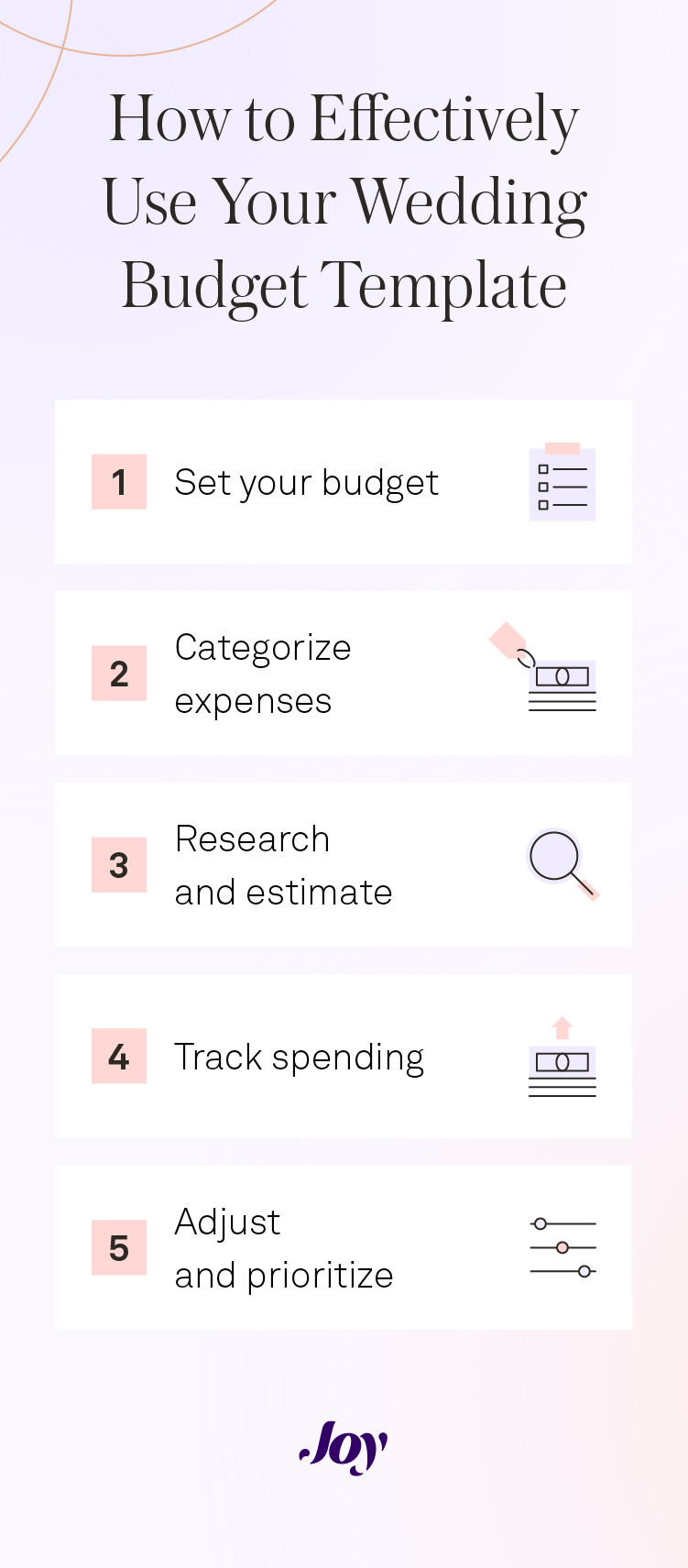Last Updated on September 13, 2024 by Joy Editors
Congratulations on your engagement! You’re probably swirling with excitement and maybe a touch of overwhelm as you dive into wedding planning. Between the venue search, guest list wrangling, and a million tiny decisions, it’s easy to feel lost in a sea of white tablecloths and floral centerpieces.
One of the best ways to navigate the whirlwind and keep your sanity intact is by creating a rock-solid budget with a wedding budget template. It’s like a financial roadmap to happily ever after, helping you stay organized, prioritize your spending, and avoid any post-wedding sticker shock. Use this free template as your secret weapon for stress-free (well, almost!) wedding planning.
Free Wedding Budget Template
For a free, downloadable wedding budget template, simply use the button below and save a copy to your Google Drive. The template is fully customizable, allowing you to adjust your budget, add or remove expenses, and personalize it to fit your unique wedding vision. It includes:
- Pre-filled categories of common expenses, such as wedding invitations and venue
- Built-in calculations to automatically tally your costs, track your spending, and make adjustments as you go

Understanding Your Wedding Budget
Before diving into how to use the template, let’s talk about understanding your wedding budget. Setting a realistic budget with your partner from the outset helps set clear expectations for what you can achieve with your wedding. Looking at a sample wedding budget can also give valuable insights into what a wedding costs.

To prioritize your spending, start by identifying your non-negotiables — the elements that are most important to you. Perhaps you dream of a stunning gown or a live band. A wedding checklist template is a helpful tool to map out your priorities. Once you’ve determined your must-haves, you can allocate a larger portion of your budget to those areas and explore cost-saving or DIY options for less critical items.
Several factors can also impact your overall wedding costs, including:
- Location: City weddings often command higher prices for venues and vendors because of increased demand and overhead costs. Destination weddings also typically come with higher price tags, as you’ll need to factor in travel expenses for you and your guests, accommodations, and potential fees.
- Guest count: More guests typically mean a larger venue, more food and drinks, and potentially additional rentals, which can add up.
- Season: Peak wedding months (like June and October) often come with higher prices for venues and vendors.
- Customization: Personalization increases costs, whether it’s swapping standard venue rental with unique options, crafting custom floral designs or curating specialized food menus. Adding these individualized touches typically requires extra time and effort, which can drive up costs.
With all that in mind, breaking down your budget into categories with a handy template can help you see where your money’s really going.
How to Use Your Wedding Budget Template
Let’s break down how to use your wedding budget template effectively for a stress-free planning journey.

Step 1. Set your budget
The first step is to determine the total amount you’re comfortable spending. This figure will serve as the foundation for your entire budget. Consider your financial situation, including income, savings, and any contributions from family or friends.
Step 2. Categorize expenses
Next, divide your total budget into specific categories. Our template includes common categories like venue, catering, photography, attire, decor, and wedding flowers. Feel free to add or customize categories to fit your unique wedding plans.
Tip: Include additional categories for insurance, hotel accommodations, or honeymoon expenses.
Step 3. Research and estimate
Once you’ve established your categories, start researching the average wedding costs for each expense. This will give you a ballpark figure to work with. Input your estimated costs into the corresponding sections of the template for a wedding cost calculator. Remember, these are just estimates, and you can adjust them as you gather more specific quotes.
Step 4. Track spending
As you book vendors and make purchases, record the actual costs in your wedding budget template. This step is crucial to stay on top of your spending and track deposits, payments, and total balances. By comparing your actual expenses to your estimates, you can identify areas where you’re on track and where you might need to cut back.
Step 5. Adjust and prioritize
Throughout the planning process, set a recurring date to review your budget and ensure you’re staying on track. Life happens, and unexpected costs may arise. If you find yourself overspending in one area, consider making adjustments to other categories.
Prioritize expenses based on what truly matters to you and your partner. For example, if high-quality photography is important, you might be willing to allocate a larger portion of your budget to this category and cut back elsewhere. Flexibility is key and your budget is a living document that can evolve as your wedding plans develop.
DIY Your Own Wedding Budget Template
If you have very specific needs for your wedding that aren’t covered in our free template, creating your own DIY wedding budget template can be a great option. Here’s a quick guide on what to include in your budget:
- Income: Start by tracking all the funds coming in for your big day. This might be your own savings, contributions from family, gifts, or any other sources of wedding money.
- Savings: Set aside a section for any extra funds you can put towards unexpected costs or post-wedding expenses.
- Expenses: This is where you’ll list all your wedding costs. Common categories include venue rental, food and drinks, photography, attire, flowers and decor, music and entertainment, invitations, the marriage license, officiant fees, the wedding cake, and rings.
Remember to tailor the template to your specific needs. For example, if you’re planning a destination wedding, you might include categories for travel expenses, guest accommodations, and location-specific permits or fees.
Benefits of Using a Wedding Budget Template
When it comes to planning your wedding, every detail counts, and staying on top of your budget can make all the difference.
- Saves Time and Effort: A wedding budget spreadsheet has pre-filled categories and formulas that handle the math for you. This means you get to skip the number-crunching and dive straight into the fun stuff, like picking out your dream wedding dress or registering for your wedding.
- Helps You Stay Organized: No more digging through piles of scribbled notes or hunting down that one spreadsheet you swear you saved. This template keeps all your wedding finances in one spot, ready for you to access with a click.
- Provides a Clear Overview of Finances: This template lays out your finances in a way that’s easy to understand so you can see exactly where your money’s going and make more informed decisions.
- Allows for Easy Tracking: Monitor your expenses by logging vendor quotes, deposits, and final payments directly in the template. Track as you go to have a clear view of your spending and identify areas for adjustments if needed.
- Enables Collaboration with Your Partner: Planning a wedding is a team effort, and a template helps simplify. Share it with your partner or wedding planner, and you’ll both have a clear view of your budget. It’s perfect for joint decision-making and ensuring you’re on the same page every step of the way.
Plan Your Perfect Day With Joy
With this wedding budget template in hand, you’re ready to take on the financial side of wedding planning. This tool simplifies your budgeting and helps you stay on top of your expenses, ensuring there are no surprises. But a solid budget is just one piece of the wedding planning puzzle, so utilize a wedding planning timeline to start crossing off those to-dos once you’ve mastered your budget. For post-wedding bliss, create your dream wedding registry to make thoughtful gift-giving easy for your loved ones.


